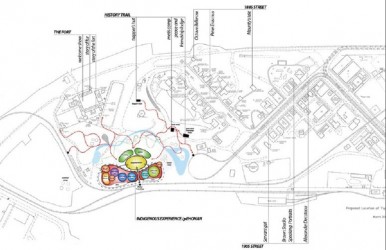Article Origin
Volume
Issue
Year
For Edmonton’s history to be fully known, the role undertaken by Indigenous people must be told.
That is the goal behind Fort Edmonton Management Company’s move to develop a new section in Fort Edmonton Park.
“(We) will be able to tell Indigenous people’s perspectives on their own history and that’s important because history can be a very political and emotional thing,” said Lewis Cardinal, director on FEMC, which took over running the park about four years ago.
Cardinal is also the chair of the Indigenous Peoples Experience, which has put forward the concept of “The Spirit of pehonan,” a re-creation of the gathering place that was in Rossdale Flats.
“This is a way to create a fuller, and I would say richer perspective of history in Edmonton that consisted of many Indigenous people participating in building this city,” Cardinal said. As Fort Edmonton stands now, history only begins with the fort in 1873 and doesn’t include the thousands of years before.
The idea of showcasing the Aboriginal aspect in developing Edmonton is one embraced enthusiastically by Edmonton Mayor Stephen Mandel.
“To give that kind of recognition is necessary so all of us begin to see the great contributions, the amazing importance of those people to making our city what it is today, our province what it is today,” Mandel said.
The City of Edmonton owns the buildings, artifacts and land associated with Fort Edmonton Park.
Cardinal is hoping to get the city, province and federal governments to ante up money toward the estimated $35 million price tag.
It’s an investment Mandel is keen on making.
“I think that’s something that needs to be a big priority of city council … and all of us to begin to recognize the important contributions of the First Nation, Métis and Inuit peoples,” said Mandel. “I think if anything it should be a priority for us to build this.”
Cardinal is pleased to get the nod from Mandel.
“He’s very supportive. He wants to see it done because he knows it will be successful,” Cardinal said. “When Indigenous people start telling their own stories, a lot of people listen.”
The land targeted for the new development is available within the park on the south side of the fort.
The proposed development, which is to be carried out in two phases, consists of exploration trails, camps, tipis, and smaller huts. Encampments will be developed by Métis as well as First Nations that came to the area, including Blackfoot, Woodland Cree, Plains Cree and Lakota in order to ensure authenticity. Larger structures will also be built, including an amphitheatre, pehonan exhibit and a performance space, and a friendship lodge. There will also be a restaurant and classrooms.
Cardinal would like to see the addition completed by 2017, in time to celebrate Canada’s 150th anniversary. Work cannot get underway until the underground infrastructure is built, which will take two and a half to three years.
Cardinal has already started making the rounds of service clubs, where he is also hoping to pick up some funding for the extensive development. He will also be targeting corporations.
FEMC has already taken steps to start including Indigenous historical figures in the park. Alexander Decouteau, the first Indigenous police officer and Olympian, is now on 1905 street and more recognized Métis people will be included within the fort.
- 2756 views

